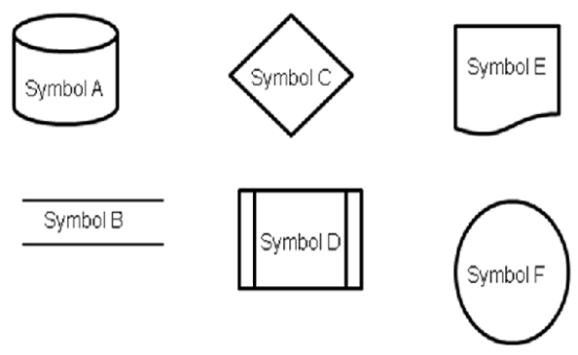Consider the following set of symbols and the ELM case as you respond to the next question: ELM Corporation sells durable medical equipment, such as wheelchairs and hospital beds; each salesperson at ELM specializes in a specific type of medical equipment. When a prospective client comes into their store, a greeter does a preliminary needs assessment to determine what type(s) of equipment the client requires. Based on that preliminary assessment, the greeter will match the client with a member of the sales staff. The staff specialist does a more detailed needs assessment, the results of which go into a computerized database along with the client's name, address, phone number and other related information. After the needs assessment, the staff specialist determines the client's budget, as well as whether the client has insurance coverage for the desired equipment; clients without insurance coverage receive a 10% discount on all equipment purchased up to $1,000, and a 20% discount for any sales over $1,000. The staff specialist makes recommendations based on the client's needs and budget. If the client chooses to purchase from ELM, the store fills out any necessary insurance paperwork and collects the client's portion of the bill. For example, if an insured client purchases a wheelchair with a price of $2,000 and the insurance covers 80%, ELM collects $400 from the client at the time of the sale. ELM accepts cash, checks and major credit cards from clients. Insurance payments go directly to ELM's bank account and normally arrive within 60 days of the sale. If the client needs more than one type of durable medical equipment, the first staff specialist introduces the client to a subsequent staff specialist, who repeats the process until all the client's equipment needs are met.  In a systems flowchart of ELM's sales / collection process, Symbol C could be labeled with any of the following except:
In a systems flowchart of ELM's sales / collection process, Symbol C could be labeled with any of the following except:
Definitions:
Naval Presence
The strategic stationing or deployment of naval forces in specific areas to project power or control maritime activities.
Chesapeake Affair
An 1807 incident between the British warship HMS Leopard and the American frigate USS Chesapeake, leading to heightened tensions between Britain and the United States.
Non-Importation Act
Legislation passed by various American colonies in the 1760s and 1770s to protest British policies by refusing to import British goods.
War Of 1812
The War of 1812 was a military conflict fought between the United States and Britain from 1812 to 1815, primarily over British restrictions on U.S. trade and America's desire to expand its territory.
Q4: After attending a seminar on the importance
Q14: McDonald suggested four characteristics necessary to be
Q20: Arriving at moral standards that regulate right
Q25: In response to information overload, decision makers
Q44: An auditor is concerned that her company's
Q50: The balance sheet of BYA Corporation reported
Q58: Business risks and threats to information systems
Q59: Fill in the blanks in each statement
Q63: What do the views of Paracelsus, Teresa
Q78: Evidence-based practice is defined in the textbook